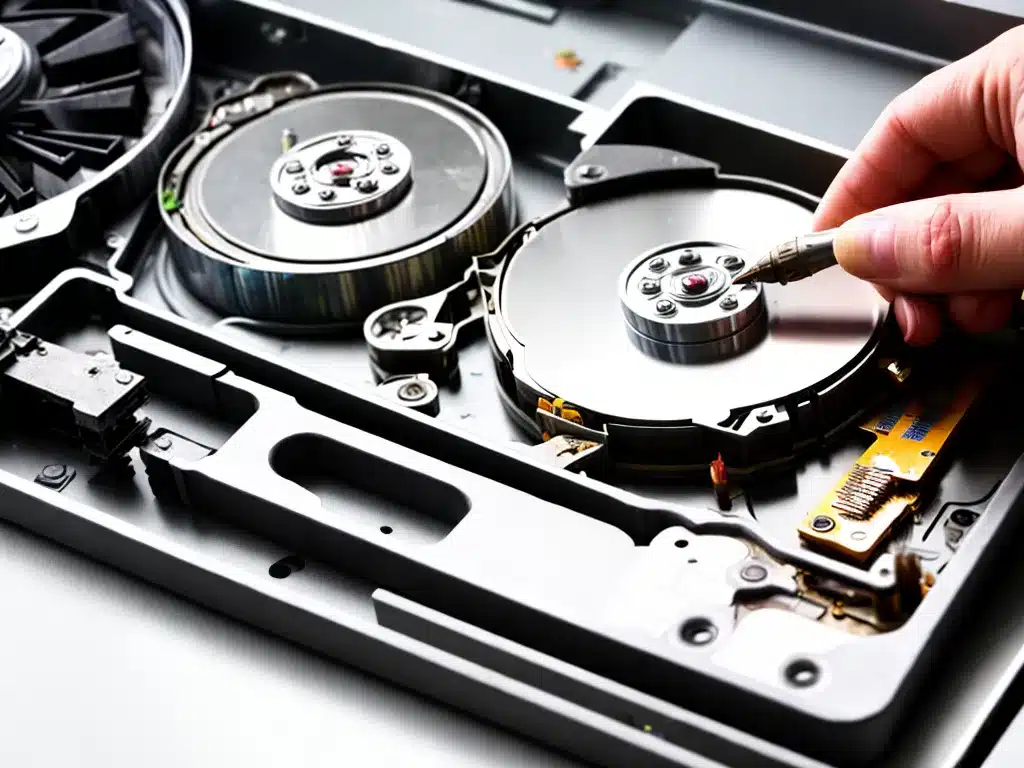
What is DIY data recovery?
DIY (do-it-yourself) data recovery refers to attempts by individuals to recover lost or deleted data from storage devices like hard drives, SSDs, USB drives, SD cards, etc., without involving a professional data recovery service.
With DIY data recovery, I typically use data recovery software that can be downloaded online and attempt the recovery process myself. The software scans the storage device, searches for deleted files and folders, and tries to recover them. I may also try some manual techniques like taking apart the device carefully and accessing the storage media directly.
The main advantages of DIY data recovery are:
-
It’s cheap – Don’t need to pay professional fees. DIY software costs between $30-100 typically.
-
Convenient – Can attempt recovery from the comfort of my home.
-
Good for minor deletions – Can potentially recover recently deleted files easily.
However, there are also some significant disadvantages:
-
Steep learning curve – Requires learning how to use data recovery software and hardware disassembly.
-
Risk of worse damage – DIY methods may damage the storage device further if not done properly.
-
Limited success – DIY tools can only do simple file carving and won’t recover from mechanical faults or serious corruption issues.
-
No expert help – Stuck on my own if the DIY process fails or hits roadblocks.
What do professional data recovery services offer?
Professional data recovery services have extensively trained experts, specialized tools and equipment, and access to spare parts and clean room facilities. Here are some key capabilities they offer:
-
Advanced tools – They use proprietary data recovery software and hardware equipment not available to consumers. These can extract data even from seriously corrupted media.
-
Spare parts – They have access to replacement parts and components for storage devices. This helps recover data from mechanically failed drives.
-
Clean rooms – They can open up and handle hard drives in dust-free clean room environments. This is essential for mechanical faults.
-
Expertise – The engineers are highly experienced and skilled in advanced data recovery techniques for all types of storage media failures.
-
High success rates – Professional services can recover data successfully in over 90% of cases by utilizing all the above capabilities.
-
Emergency services – Critical/time-sensitive cases can be handled via expedited emergency recovery options.
The disadvantage is that professional data recovery can be very expensive, often costing $500 to $3000 or more depending on the case complexity.
When should I try DIY vs. using a pro service?
Try DIY data recovery if:
-
Deletion was recent and drive is intact – Higher chances of file carving working.
-
Data is not critically important – Can take risks trying DIY without worrying about permanent loss.
-
Issue is software corruption – Beyond my technical skill but software tools may be able to fix it.
-
Cost is a major factor – Professional service is too expensive for your situation.
Use a professional service if:
-
Mechanical failure is suspected – Needs hardware access and clean room.
-
Drive makes abnormal noises or has severe issues – It requires delicate expert handling.
-
Very valuable or irreplaceable data – Highest chances of recovery are needed.
-
Failed DIY attempts – A professional service may still be able to recover after a botched DIY attempt.
-
Urgent turnaround is required – Professionals can expedite if needed.
-
Specific expertise needed – Like SSD drive failure, RAID recovery, etc. require niche skills.
How can I prepare for DIY data recovery?
If attempting DIY recovery, here are some tips to prepare:
-
Research – Read guides to understand the steps involved and risks. Watch video tutorials by experts.
-
Select software – Investigate and select reputable software like Recuva, Stellar Phoenix, R-Studio, etc. based on your case. Avoid untested free software.
-
Backups – Take images or clones of the drive before attempting recovery, to preserve the current state.
-
Equipment – Have necessary hardware like external drives, write blockers, SATA/USB adapters ready.
-
Take precautions – Follow best practices, like handling the drive carefully and disassembling properly.
-
Know when to stop – If too risky or beyond your skill, stop and engage a professional to avoid making things worse.
How to choose the right data recovery service?
If DIY doesn’t work and you need a professional service, look for one with:
-
Good reputation – Check reviews and testimonials online. Ask for references from past clients.
-
Experienced experts – Ask about the experience levels and certifications of their engineers and clean room techs.
-
Advanced capabilities – They should discuss the range of failures they can handle, like mechanical issues, water damage, SSD failures etc.
-
Explains process – They should assess your device, explain failure modes, and detail the recovery process.
-
Reasonable pricing – Cost varies based on case complexity but should not be disproportionately exorbitant.
-
Secure process – They must guarantee the security of your recovered data.
-
No upfront payment – Fees should be charged only if recovery is successful, not before.
-
Return of failed drives – The failed media should be returned even if recovery fails, for you to dispose of safely.
Conclusion
DIY data recovery has its place for simpler cases but professional services offer much higher chances of successful recovery from complex failures. Assess your specific situation carefully, prepare diligently for DIY if attempting it, but know when to seek expert help to get the best chances of recovering your lost data.












